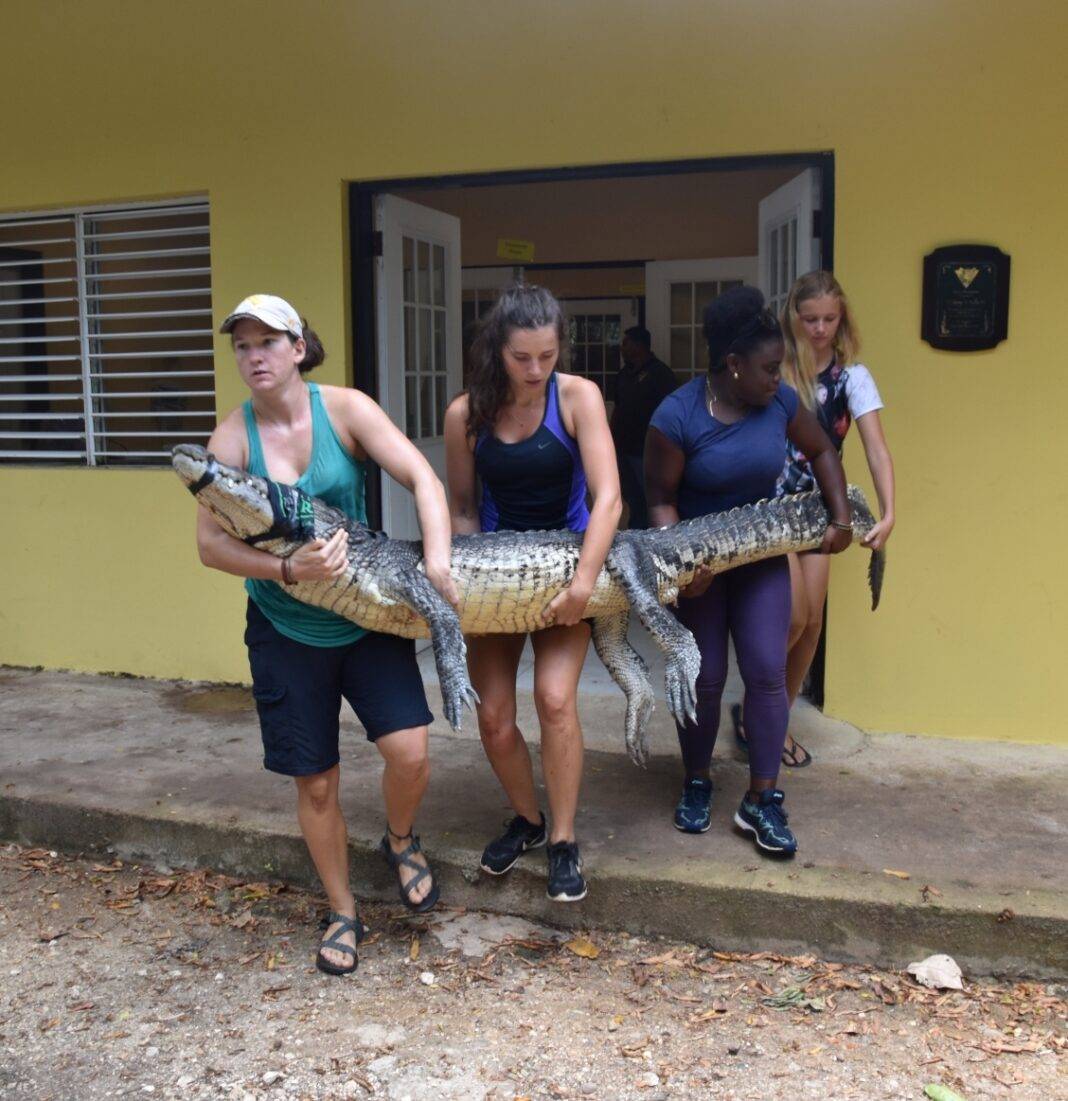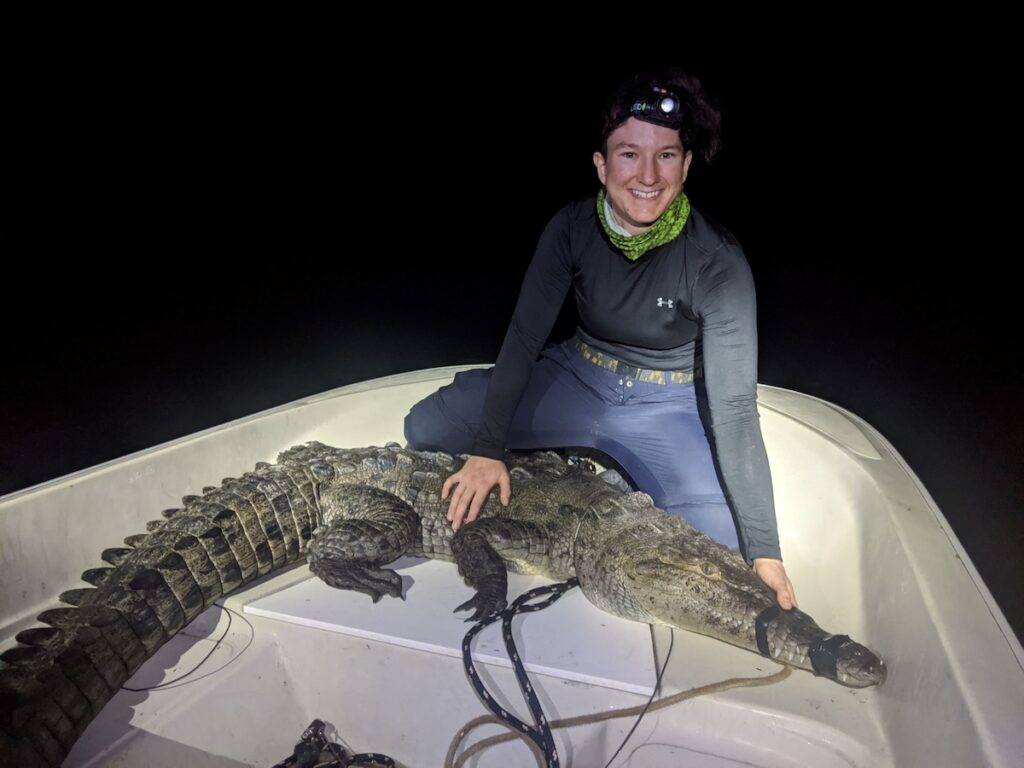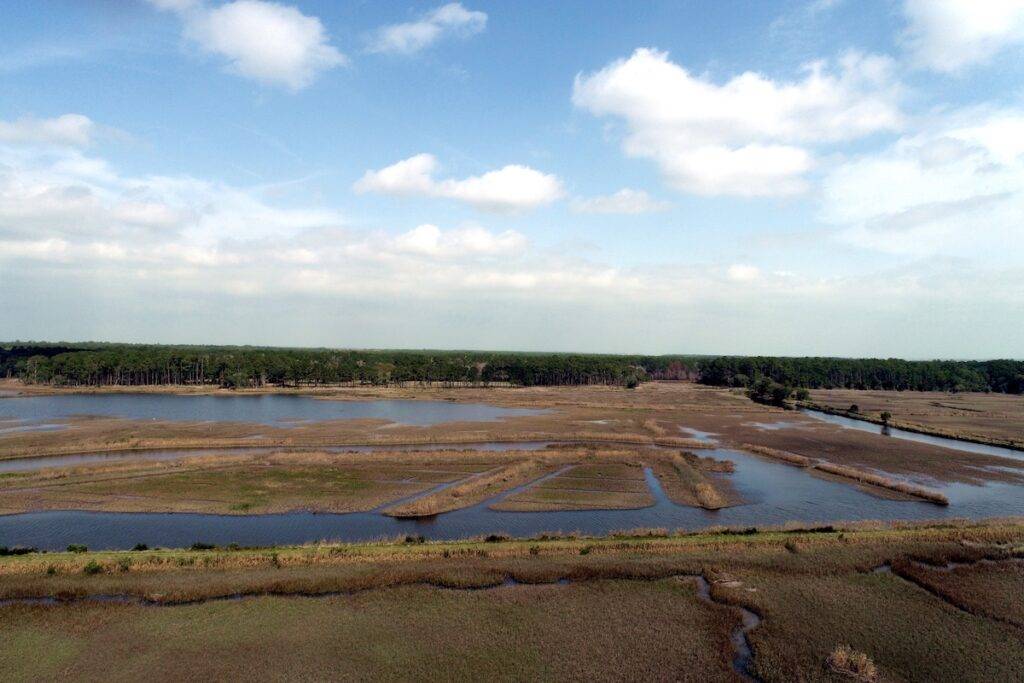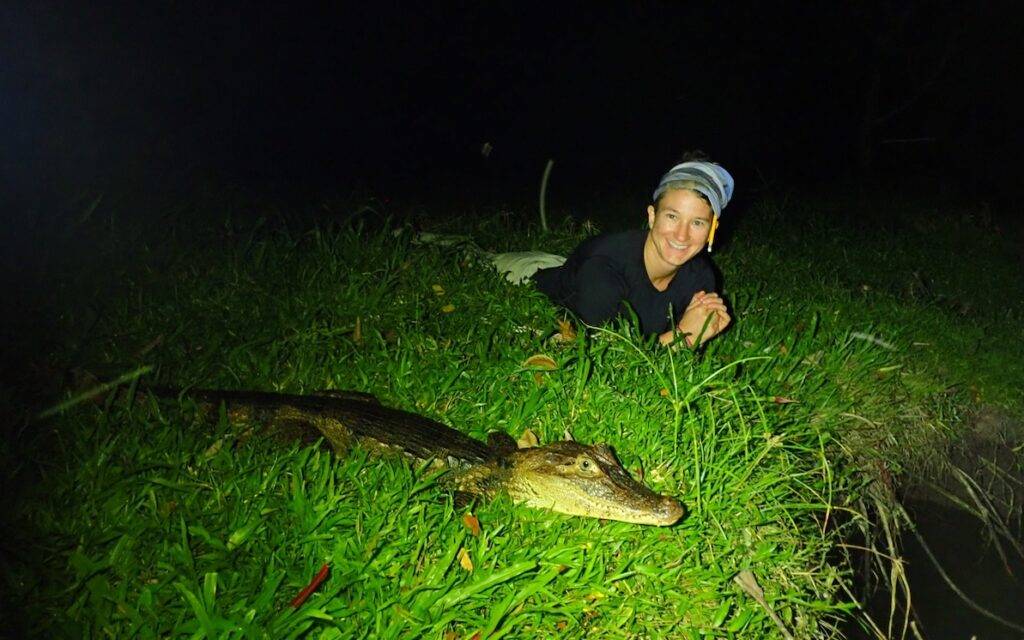Alligator hunter Miriam Boucher (don’t worry, she’s just studying them) is living her dream in the swamps of South Carolina.
Swamps, with their mosquitos, snakes, and mud, are not really places where most of us want to spend much time, especially in the dark. Miriam Boucher, however, is not like most of us. “Being in the back of a boat with the salty wind in your face, only able to see what is directly ahead of you in the spotlight, is my happy place. I’m the first one in and the muddiest one out.” Miriam is hunting alligators — not to kill them, but to learn from them.
Environmental scientists have long considered alligators and crocodiles to be some of the best monitors of environmental health for our planet. Their size and position at the top of the food chain means that scientists can track microplastics from the bottom of the food chain to the top. Also, because of the reptiles’ longevity, this tracking can take place over decades. As apex predators, alligators and crocodiles are territorial, which makes them easy to locate for follow-up research. All the pollutants they encounter, including pollutants in animals they eat, leave a residue in their bodies. This residue provides scientists with essential information about contaminants like mercury in our environment.
Miriam, a graduate research assistant working on her doctorate at South Carolina’s Clemson University in the James C. Kennedy Waterfowl and Wetlands Conservation Center, is continuing this line of research and applying it to a type of pollutant we are hearing a great deal about lately — microplastics. Microplastics pollute the air, soil, and water, and have been found in coastal wildlife such as ospreys. As plastic pollution in the sea has reached critical levels, coastal areas are the most seriously impacted.
The buildup of microplastics in animals’ bodies can poison them or lead to starvation and death. Data about microplastics in wildlife is critical information when looking at overall environmental health. We haven’t yet determined the long-term consequences of microplastics for human health, but we know they are finding their way into our bodies, too, making Miriam’s research, along with others’, vital.
The coast of South Carolina, where Miriam is conducting her research, is made up of historic wetlands. Many of these are the remains of rice impoundments that were built by enslaved people in the 17th century and, at one time, covered nearly one-third of South Carolina’s 504,000 acres of coastal wetlands. The historical, economic, and cultural significance of these wetlands is enormous, since rice plantations created most of the wealth in the region.
Following the Civil War, the end of slavery, and competition from rice growers in Britain and the Southwestern US, the rice industry in South Carolina wound down. But the changes created by the plantations to the natural tidal flood plains remain. Berms — large human-made embankments and terraces that border extensive canal irrigation systems — have fallen into disuse by humans. But wildlife has capitalized on these structures, and the conditions they create have proven especially beneficial to waterfowl and other wetland creatures, including alligators.
Miriam had an early fascination with crocodiles and alligators. Miriam’s family gave her a zoo pass and she spent as much time as possible in the reptile house. One day she was lucky enough to observe a zookeeper handling an American alligator. She was enthralled. It took the naturally shy little girl a few minutes to gather the courage to approach the zookeeper, but she was rewarded when he allowed her to touch her first alligator.
In the first grade, when given an assignment on future careers, she drew a picture of herself with a crocodile and a telemetry antenna, like those used by conservationists on television when they track wild animals. She did not know exactly what a crocodile biologist did, but she knew that they hung out with her favorite animals, and that was good enough for her.
After completing her environmental biology degree, Miriam continued to pursue her dream to work with alligators and crocodiles. She headed to a crocodile sanctuary in Belize, where she met Dr. Marisa Tellez, founder of the Crocodile Research Coalition and a noted expert on the behavior and physiology of crocodiles. She began assisting Dr. Tellez as a technician — a priceless opportunity since Dr. Tellez is one of the few people in the world with an expertise in flushing the stomachs of wild crocodiles. Miriam, an eager student, gained hands-on experience not only in stomach-flushing, but also in capturing wild crocodiles at night while waist deep in putrid swamp water. It seemed she had found her mentor.
Miriam returned to the US to complete her masters in Fish and Wildlife Science at West Virginia University. “It was tough,” she said, referring to being a woman in a male-dominated field. “I felt I had everything to prove and always owed people just because they had given me a chance.” But her passion and determination led to her current research, which will provide a snapshot of the impact of microplastics in the environment. Miriam is utilizing the skills she learned in Belize, to capture live alligators in order to flush their stomachs. She is also working with licensed hunters and trappers in the southeastern US to collect the stomachs of dead alligators, a collaboration that ensures that the research includes data from as many alligators as possible, while also helping to build bridges between those conserving wildlife and those who hunt it.
Alligator stomachs provide valuable information about where the microplastics are originating and how they are passing through the food chain. “We know microsplastics are everywhere in the environment. That creates a daunting task to quantify and monitor it long-term at a large scale. The size, shape, and color of microplastics can be used to figure out where it came from,” she explains. “For example, small black rubber particles come from the wearing of vehicle tires, and brightly colored fibers are likely synthetic fibers from clothing that are washed in peoples’ homes and enter the environment from wastewater treatment plants. By examining other stomach contents, such as bones, fish scale, and crab shells, researchers can determine what the alligators are eating and analyze whether their diet is related to the amount and type of microplastics we find in their stomachs.”
“We need to always be mindful of our influence on nature, especially the ways we manage our own waste,” says alligator researcher Miriam Boucher. “Right now it all ends up in wild spaces, and this is not sustainable.”
Dr. Tellez believes Miriam’s research will accelerate our understanding of the ways that microplastics are affecting not only wildlife, but humans, too. And she is confident that Miriam’s research will help guide future conservation initiatives and wildlife management practices. While scientists like Miriam gather more information about these ancient reptiles and establish their importance as essential biomonitors, they also prioritize community education. Conservation and protection of these species requires cooperation and understanding. “We need to always be mindful of our influence on nature, especially the ways we manage our own waste. Right now it all ends up in wild spaces, and this is not sustainable. As far as alligators are concerned, newcomers need to understand that they are all over the southeast United States. They can be safely appreciated and lived with as long as people remember: If you wouldn't stick your head in a cave in bear territory, it might not be a good idea to stick your hand in a pond in alligator territory.”
Bringing hunters and trappers on board is part of this community outreach. Working with them directly gives Miriam the opportunity to help them better understand the environmental value of these prehistoric animals and to become advocates for protecting their habitats. She also attends local events to teach communities how to appreciate and live with alligators safely. Miriam is now an alligator and crocodile expert in her own right and is currently mentoring ten undergraduate students, teaching them about crocodilian ecology, biology, and ecotoxicology, and giving them hands-on experience with specialist field skills. The shy girl who loved crocodiles is now helping others to achieve their dreams of working with these creatures — and to conduct research that benefits all of us.





